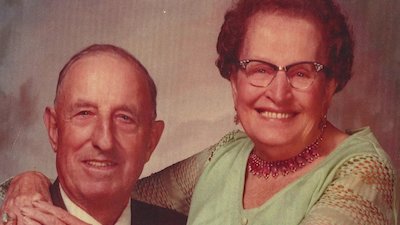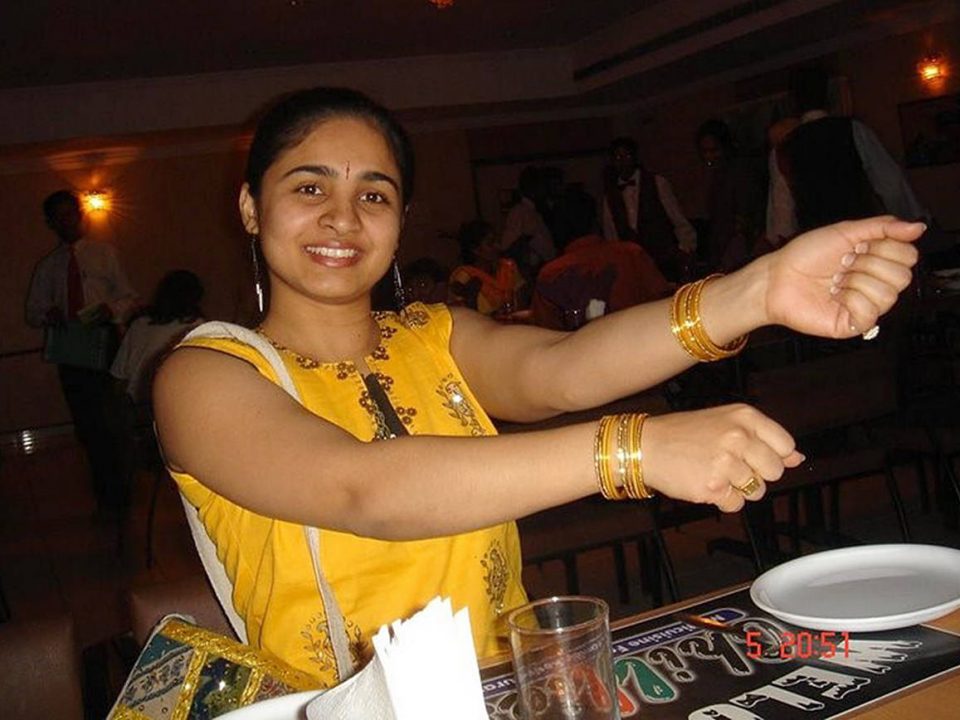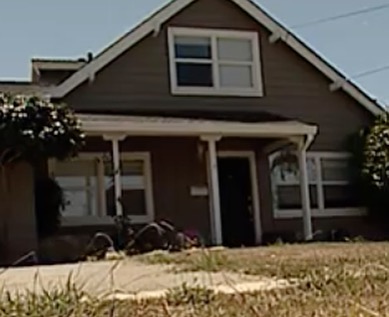The Infamous OJ Simpson Case: A Detailed Look at the Trial of the Century
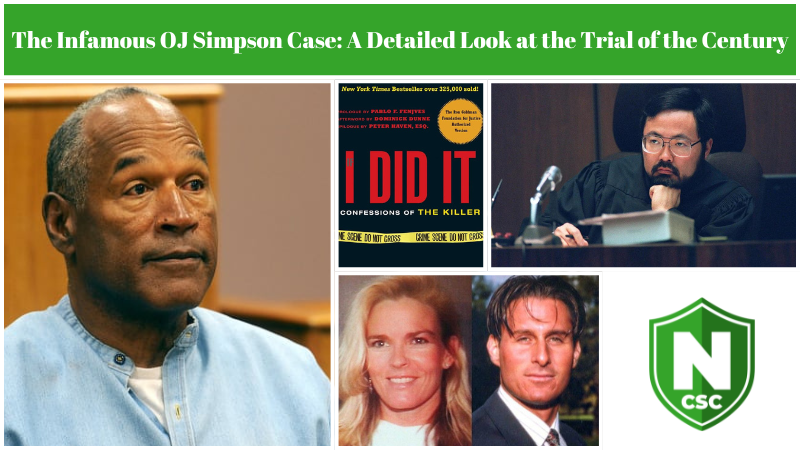
As most may already know by now O.J. Simpson passed away on April 10th, 2024 marking the end of a tumultuous chapter in American legal history. The trial of the century, as it came to be known, captivated the nation’s attention in the mid-1990s, highlighting issues of race, fame, and the criminal justice system. Simpson’s acquittal for the murders of Nicole Brown Simpson and Ron Goldman sparked debate and controversy that reverberated for years to come. In this article we will reexamine the case, its impact, and the events that surrounded it, shedding new light on one of the most sensationalized trials in modern memory.
Introduction to the OJ Simpson Case: The Background and Context
Here is a little back ground to The OJ Simpson case, also known as the “Trial of the Century”:
Murder and Initial Arrest
On June 12, 1994, Nicole Brown Simpson, the ex-wife of former NFL star OJ Simpson, and her friend Ron Goldman were found brutally murdered outside Nicole’s home in Los Angeles. The following day on June 13, 1994 the police go to Simpson’s Rockingham mansion to inform him about the death of his wife. Once they arrive they discover his blood-stained white Bronco as well as a bloody glove that matched one found near Goldman’s body. With a search warrant in hand the police search Simpson’s mansion to find even more traces of blood. This lead to the beloved (at the time) football player and actor quickly being identified as the prime suspect in the double homicide. Simpson had left town the night before boarding a flight to Chicago. Once he was informed about the deaths he returned to Los Angeles where he was arrested and questioned for hours.
The White Bronco Chase
This may be one of the most memorable moments from the OJ story, the highly televised chase. On June 17, 1994 once OJ Simpson was formally charged with the murder his ex-wife and her friend he flees and becomes a fugitive despite promising to surrender to authorities. He is later spotted on the freeway in his white Ford Bronco with his friend Al “A.C.” Cowlings as the get away driver. As helicopters captured the slow-speed chase which lasted over 2 hours it drew the attention of the media and eventually the public at large. The televised chase is estimated to have been viewed by 95 million people with many fans lining up along the freeway to cheer on OJ in his getaway attempt. This story was so big at the time that it even interrupted the broadcast of the NBA Finals. Eventually presumably seeing no way out Simpson returns to his home where he surrenders and is ultimately arrested and jailed without bail.
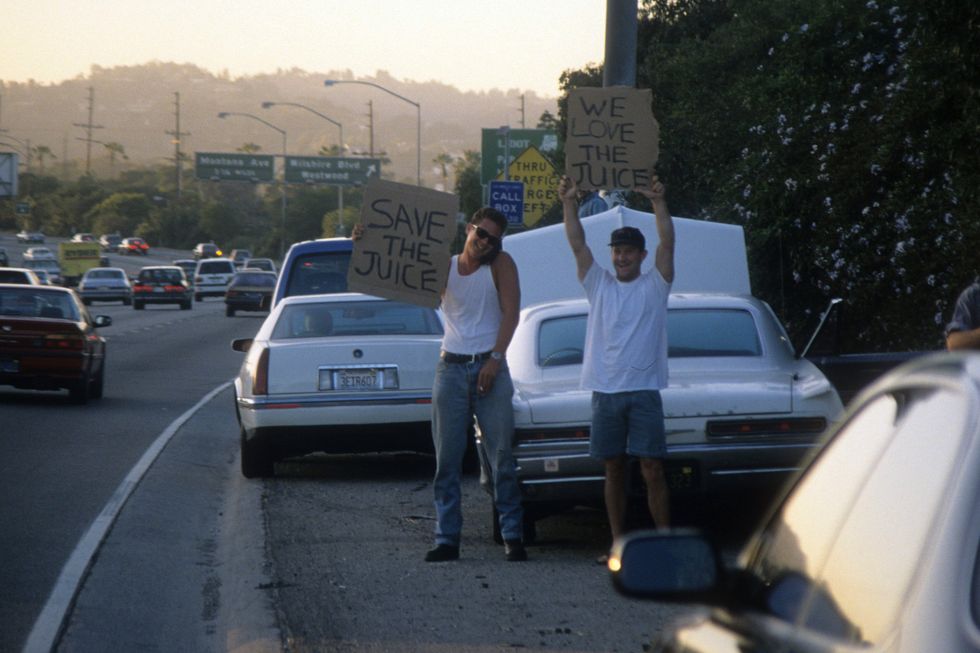
Fans cheer as OJ attempts to evade police
The Key Players in the Trial: OJ Simpson, Marcia Clark, Johnnie Cochran, and Judge Lance Ito
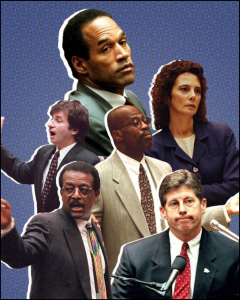
Key Players In The Trial Of The Century
At the center of this legal drama were several key players whose actions and decisions would shape the outcome of the trial.
On the defense team, OJ Simpson was represented by a formidable group of lawyers led by Johnnie Cochran. Cochran’s skillful cross-examinations and closing arguments played a major role in securing Simpson’s acquittal. Also on the defense were Robert Shapiro, F. Lee Bailey, and Alan Dershowitz, all renowned attorneys in their own right.
Opposing the defense was the prosecution team, headed by Marcia Clark and Christopher Darden. As the lead prosecutors, Clark and Darden worked tirelessly to build a case against Simpson, but ultimately fell short in convincing the jury of his guilt.
Presiding over the entire trial was Judge Lance Ito, whose management of the proceedings was at times criticized as overly permissive. Ito’s rulings and handling of the media attention played a significant role in shaping the trial’s outcome.
The interplay between these key figures – the defense, prosecution, and judge – made the OJ Simpson trial a landmark event that continues to be studied and debated by legal scholars and the public alike.
The Trial of the Century: Courtroom Drama and Legal Strategies Unfold
The investigation into the high-profile murder case was a complex and contentious affair, marked by extensive forensic analysis and intense public scrutiny. At the heart of the case was a wealth of physical evidence, including DNA samples and a notorious glove that became a focal point of the trial. Here we will breakdown different aspects of the courtroom drama from the glove that didn’t fit to the racial component of the trial.
The Prosecution’s Strategy
The prosecution asserted in their opening statement that Simpson had killed his his ex-wife out of jealousy with Christopher Darden mentioning that “He killed her because he couldn’t have her.” To build their case they relied heavily on the following:
- Physical Evidence: The prosecution presented a significant amount of physical evidence linking O.J. Simpson to the crime scene, including blood evidence, DNA analysis, and fibers from Simpson’s Bronco and home.
- Timeline and Motive: The prosecution sought to establish a timeline of events that would place Simpson at the scene of the crime at the time of the murders. They also presented a motive, suggesting that Simpson was jealous and possessive of Nicole Brown Simpson.
- Domestic Violence History: The prosecution introduced evidence of Simpson’s history of domestic violence against Nicole, suggesting a pattern of abusive behavior that could have culminated in the murders.
- Glove Evidence: Perhaps the most memorable part of the prosecutions strategy was to have Simpson try on a bloody glove found at the crime scene and a matching glove found at Simpson’s home.
- Eyewitness Testimony: The prosecution relied on the testimony of witnesses who claimed to have seen Simpson near the crime scene on the night of the murders.
Overall, the prosecution aimed to present a compelling case based on both circumstantial and physical evidence, supported by witness testimony, to convince the jury of Simpson’s guilt.
The Defense’s Strategy
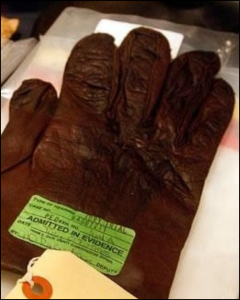
The Glove Found at Crime Scene
The defense team, led by Johnnie Cochran, employed a strategic defense that ultimately proved successful. Some key elements of their strategy included:
- Focus on Police Misconduct: The defense heavily criticized the police investigation, alleging misconduct, mishandling of evidence, and even planting of evidence. This strategy aimed to create doubt about the integrity of the prosecution’s case.
- Race as a Factor: The defense team made race a central theme of the trial, suggesting that Simpson was being framed because he was a prominent black man. This strategy resonated with the predominantly African American jury and tapped into broader issues of racial tension and injustice.
- Attack on DNA Evidence: The defense challenged the reliability of the DNA evidence, arguing that it could have been contaminated or mishandled, thereby casting doubt on its validity.
- Alternative Suspects: The defense suggested alternative suspects who could have committed the murders, including drug dealers or individuals associated with Nicole Brown Simpson’s social circle.
- The Glove Demonstration: The prosecution’s dramatic glove demonstration, where Simpson tried on the bloody glove found at the crime scene, was a pivotal moment. The ill-fitting glove was used by the prosecution to suggest that Simpson could not have committed the murders.
- Character Witnesses: The defense called upon numerous character witnesses who testified to Simpson’s good character, aiming to portray him as a loving father and a well-respected figure in the community.
- Focus on Reasonable Doubt: Throughout the trial, the defense consistently emphasized the concept of reasonable doubt, urging the jury to acquit if they had any doubts about Simpson’s guilt.
Overall, the defense’s strategy was to create doubt in the minds of the jury regarding Simpson’s guilt, highlighting inconsistencies in the prosecution’s case and presenting alternative explanations for the evidence presented.
Key Moments in the Trial That Lead to Simpson’s Acquittal
Cross Examination of criminologist Dennis Fung
Dennis Fung was a key witness for the prosecution in the O.J. Simpson trial. As the Los Angeles Police Department criminalist who collected and processed evidence from the crime scene, Fung’s testimony was crucial in establishing the chain of custody for the physical evidence. During cross-examination, the defense team questioned Fung’s handling of the evidence, suggesting that he had mishandled or contaminated it. They also questioned his credibility and the integrity of the LAPD’s investigation. Fung ultimately admitted that proper protocols weren’t entirely enforced at the scene of the crime creating the initial bit of doubt in the jury.
“The Fuhrman Tapes”

Mark Fuhrman
At the start of the trial the Cochran claimed that he would be able to provide undeniable evidence that Mark Fuhrman, the detective involved in the investigation, was a racist and had a history of police misconduct. Since Fuhrman was the one who discovered the glove and provided a testimony for the prosecution’s case the defense’s strategy was aimed at discrediting Fuhrman’s character and eluding to the possibility that the evidence might have been planted.
The undeniable evidence that Cochran promised came in the form of “The Fuhrman Tapes” which are 13 hours of taped interviews given by Fuhrman to writer Laura McKinny. McKinny had originally conducted these interviews to get a male perspective for her screenplay and novel about the experience of women police officers. The recordings unveiled many disturbing things about Fuhrman including the fact that he was part of a group of officers known as MAW or Men Against Women. In the recordings he claimed that they would engage in sexual harassment and intimidation of female officers endangering their well being.
The tapes also revealed Fuhrman using racial slurs numerous times and expressing incredibly racist attitudes towards African Americans. This proved to be a major blow to the prosecution since Fuhrman denied being a racist and using racial slurs earlier in the trial. The tapes also exposed him admitting to numerous cases of police misconduct which further increase the likelihood that the evidence was planted in the eyes of the jury.
“If it doesn’t fit, you must acquit”
Even with surface level knowledge of this case most people would be familiar with the famous glove that played a pivotal role in the outcome of the trial. What the prosecution hoped to be one of their strongest pieces of evidence ended up backfiring on them. There was one glove found at the crime scene and another one found at Simpson’s residence, both were covered in blood. The prosecution’s plan was to make Simpson try on both gloves in front of the jury to prove that the gloves were in fact his. When Simpson tried the gloves he struggled to get on eventually holding his hands up to the jury simply saying “too tight”.
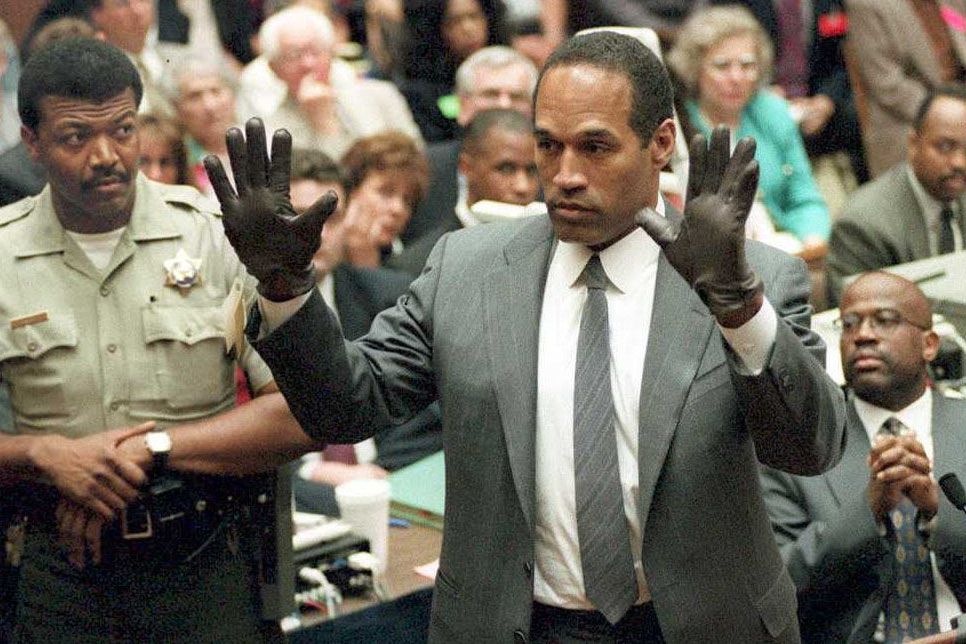
OJ Simpson during the glove demonstration
Despite the amount of DNA evidence, motive on part of Simpson and the fact that he fled the scene these key moments in the trial created enough reasonable doubt in the minds of the jury which lead to his acquittal.
The Aftermath of the Verdict: Public Reaction and Legacy of the OJ Simpson Case
The verdict in the OJ Simpson case was one of the most polarizing and widely debated legal outcomes in modern history. When the former football star was acquitted of the murders of his ex-wife Nicole Brown Simpson and her friend Ronald Goldman, it sparked intense reactions from the public.
The not guilty verdict was seen by many in the Black community as a long-overdue victory against a criminal justice system that has historically oppressed people of color. However, it also highlighted the deep racial tensions still prevalent in America. The trial’s jury, which was majority Black, was perceived by some as having let Simpson go free despite seemingly overwhelming DNA evidence.
The media coverage of the trial’s aftermath was relentless, as the public remained captivated by every development. The civil trial that later found Simpson liable for the wrongful deaths was seen by some as a belated pursuit of justice. The case’s impact continues to be felt, having shaped public perceptions around the role of race, celebrity, and forensic evidence in criminal trials.


